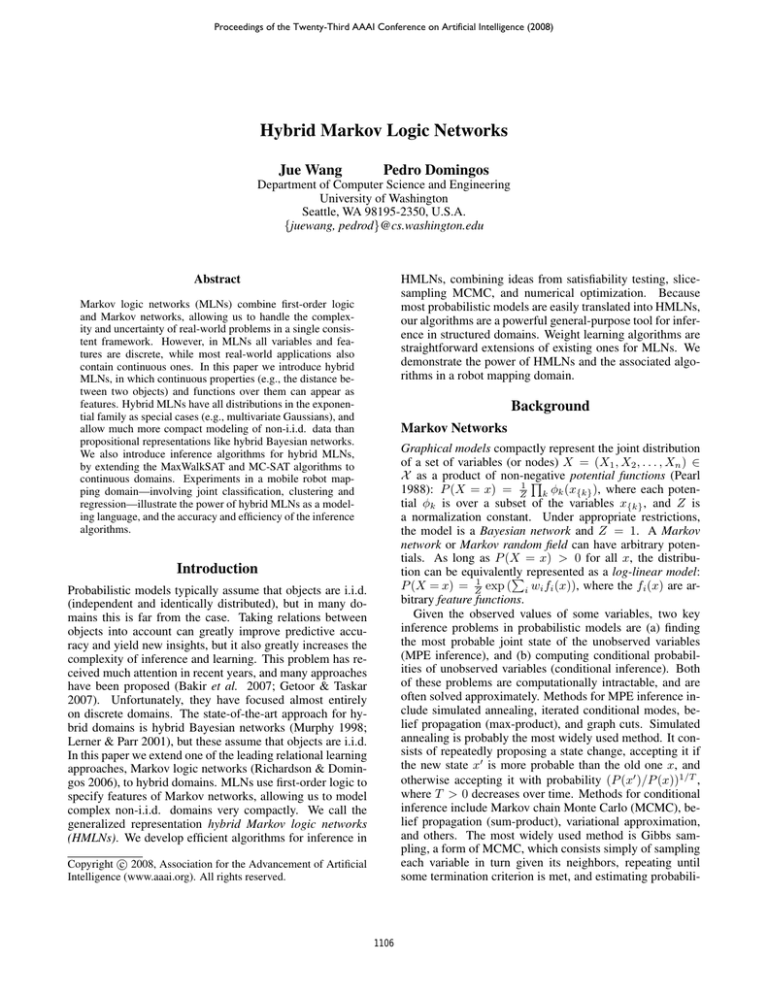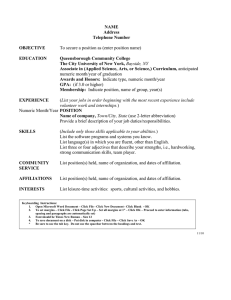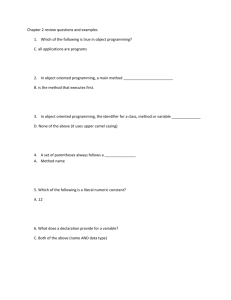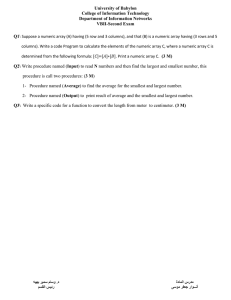
Proceedings of the Twenty-Third AAAI Conference on Artificial Intelligence (2008)
Hybrid Markov Logic Networks
Jue Wang
Pedro Domingos
Department of Computer Science and Engineering
University of Washington
Seattle, WA 98195-2350, U.S.A.
{juewang, pedrod}@cs.washington.edu
Abstract
HMLNs, combining ideas from satisfiability testing, slicesampling MCMC, and numerical optimization. Because
most probabilistic models are easily translated into HMLNs,
our algorithms are a powerful general-purpose tool for inference in structured domains. Weight learning algorithms are
straightforward extensions of existing ones for MLNs. We
demonstrate the power of HMLNs and the associated algorithms in a robot mapping domain.
Markov logic networks (MLNs) combine first-order logic
and Markov networks, allowing us to handle the complexity and uncertainty of real-world problems in a single consistent framework. However, in MLNs all variables and features are discrete, while most real-world applications also
contain continuous ones. In this paper we introduce hybrid
MLNs, in which continuous properties (e.g., the distance between two objects) and functions over them can appear as
features. Hybrid MLNs have all distributions in the exponential family as special cases (e.g., multivariate Gaussians), and
allow much more compact modeling of non-i.i.d. data than
propositional representations like hybrid Bayesian networks.
We also introduce inference algorithms for hybrid MLNs,
by extending the MaxWalkSAT and MC-SAT algorithms to
continuous domains. Experiments in a mobile robot mapping domain—involving joint classification, clustering and
regression—illustrate the power of hybrid MLNs as a modeling language, and the accuracy and efficiency of the inference
algorithms.
Background
Markov Networks
Graphical models compactly represent the joint distribution
of a set of variables (or nodes) X = (X1 , X2 , . . . , Xn ) ∈
X as a product of non-negative
potential functions (Pearl
Q
1988): P (X = x) = Z1 k φk (x{k} ), where each potential φk is over a subset of the variables x{k} , and Z is
a normalization constant. Under appropriate restrictions,
the model is a Bayesian network and Z = 1. A Markov
network or Markov random field can have arbitrary potentials. As long as P (X = x) > 0 for all x, the distribution can be equivalently
P represented as a log-linear model:
P (X = x) = Z1 exp ( i wi fi (x)), where the fi (x) are arbitrary feature functions.
Given the observed values of some variables, two key
inference problems in probabilistic models are (a) finding
the most probable joint state of the unobserved variables
(MPE inference), and (b) computing conditional probabilities of unobserved variables (conditional inference). Both
of these problems are computationally intractable, and are
often solved approximately. Methods for MPE inference include simulated annealing, iterated conditional modes, belief propagation (max-product), and graph cuts. Simulated
annealing is probably the most widely used method. It consists of repeatedly proposing a state change, accepting it if
the new state x0 is more probable than the old one x, and
otherwise accepting it with probability (P (x0 )/P (x))1/T ,
where T > 0 decreases over time. Methods for conditional
inference include Markov chain Monte Carlo (MCMC), belief propagation (sum-product), variational approximation,
and others. The most widely used method is Gibbs sampling, a form of MCMC, which consists simply of sampling
each variable in turn given its neighbors, repeating until
some termination criterion is met, and estimating probabili-
Introduction
Probabilistic models typically assume that objects are i.i.d.
(independent and identically distributed), but in many domains this is far from the case. Taking relations between
objects into account can greatly improve predictive accuracy and yield new insights, but it also greatly increases the
complexity of inference and learning. This problem has received much attention in recent years, and many approaches
have been proposed (Bakir et al. 2007; Getoor & Taskar
2007). Unfortunately, they have focused almost entirely
on discrete domains. The state-of-the-art approach for hybrid domains is hybrid Bayesian networks (Murphy 1998;
Lerner & Parr 2001), but these assume that objects are i.i.d.
In this paper we extend one of the leading relational learning
approaches, Markov logic networks (Richardson & Domingos 2006), to hybrid domains. MLNs use first-order logic to
specify features of Markov networks, allowing us to model
complex non-i.i.d. domains very compactly. We call the
generalized representation hybrid Markov logic networks
(HMLNs). We develop efficient algorithms for inference in
c 2008, Association for the Advancement of Artificial
Copyright °
Intelligence (www.aaai.org). All rights reserved.
1106
ties from counts over the sampling run (Gilks et al. 1996).
Markov network weights can be learned from data using
a variety of methods, including convex optimization of the
likelihood or a related function, iterative scaling, and margin
maximization. Network structure can also be learned from
data, typically by performing a greedy search over conjunctions of variables (Pietra et al. 1997).
sampling or other standard techniques, but in practice these
can be extremely slow when weights are large (representing strong dependencies), and break down when weights are
infinite (deterministic dependencies). Recently, Poon and
Domingos (2006) introduced MC-SAT, which handles determinism and achieves very large speedups by combining
MCMC with satisfiability testing. MC-SAT is a slice sampler with one auxiliary variable per clause. Slice samplers
alternately sample the state and auxiliary variables. The goal
of the auxiliary variables is to decorrelate the state ones, enabling rapid mixing. In state x, MC-SAT samples the auxiliary variable uk corresponding to clause fk uniformly from
[0, ewk fk (x) ]. It then samples a new state uniformly from
the “slice,” i.e., the states compatible with the auxiliary vector u. This is done using the SampleSAT algorithm, which
achieves near-uniform sampling at near-WalkSAT speeds by
mixing WalkSAT and simulated annealing steps (Wei et al.
2004). Poon and Domingos showed that MC-SAT satisfies
ergodicity and detailed balance. In essence, MC-SAT is fast
because it uses a SAT solver to jump between modes, instead of waiting exponential time for the Markov chain to
drift from one to the other, as in other MCMC methods.
MLN weights can be learned generatively using pseudolikelihood (Richardson & Domingos 2006) or discriminatively using a variety of techniques (Lowd & Domingos
2007). MLN structure can be learned using a form of inductive logic programming (Kok & Domingos 2005).
Logic and Satisfiability
A first-order knowledge base (KB) is a set of sentences or
formulas in first-order logic (Genesereth & Nilsson 1987).
First-order logic allows us to compactly represent complex
relational structure. A central problem in logic is that of
determining if a KB (usually in clausal form) is satisfiable,
i.e., if there is an assignment of truth values to ground atoms
that makes the KB true. One approach to this problem is
stochastic local search, exemplified by the WalkSat solver
(Selman et al. 1996). Beginning with a random truth assignment, WalkSat repeatedly flips the truth value of either
(a) an atom that maximizes the number of satisfied clauses,
or (b) a random atom in an unsatisfied clause. The weighted
satisfiability problem is a variant of satisfiability where each
clause has an associated weight, and the goal is to maximize
the sum of the weights of satisfied clauses. MaxWalkSat is
an extension of WalkSat to this problem (Kautz et al. 1997).
Numerical Optimization
Our inference algorithms use numerical optimization as a
subroutine. Numerical optimization is the problem of finding the inputs to a function that maximize (or minimize) its
value. Gradient descent is a popular technique, but can be
very slow. We use L-BFGS, a state-of-the-art quasi-Newton
method (Liu & Nocedal 1989), which uses the Hessian matrix (second derivatives) in addition to the gradient. L-BFGS
scales to large problems by computing a running approximation of the inverse Hessian instead of storing the full matrix.
Hybrid Markov Logic Networks
Representation
Conceptually, extending MLNs to numeric and hybrid domains is quite straightforward: it suffices to allow numeric
properties of objects as nodes, in addition to Boolean ones,
and numeric terms as features, in addition to logical formulas. Since the syntax of first-order logic already includes
numeric terms, no new constructs are required. A numeric
term is a term of numeric type, and a numeric property is a
designated function of numeric type. For example, if we are
interested in distances between objects as random variables,
we can introduce the numeric property Distance(x, y).
Markov Logic Networks
First-order logic is brittle because formulas are hard constraints; violating a single formula has the same effect as
violating all. The basic idea in MLNs is to allow soft constraints: when a world violates one formula it becomes less
probable, but not impossible. Each formula has an associated weight that reflects how strong a constraint it is. Together with a set of constants, an MLN defines a Markov
network with one node per ground atom and one feature
per ground clause. The weight of a feature is the weight
of the first-order clause that originated it. The probability of a state
P x in such a network is given by P (x) =
(1/Z) exp ( i wi fi (x)), where Z is a normalization constant, wi is the weight of the ith clause, fi = 1 if the ith
clause is true, and fi = 0 otherwise. An MLN can be viewed
as a template for constructing Markov networks. Most commonly used probabilistic models can be succinctly formulated as MLNs, including HMMs, CRFs, logistic regression,
Bayesian networks, etc.
MPE inference in MLNs can be performed using a
weighted satisfiability solver like MaxWalkSAT. In principle, conditional inference can be performed using Gibbs
Definition 1 A hybrid Markov logic network L is a set of
pairs (Fi , wi ), where Fi is a first-order formula or a numeric term, and wi is a real number. Together with a finite
set of constants C = {c1 , c2 , . . . , c|C| }, it defines a Markov
network ML,C as follows:
1. ML,C contains one node for each possible grounding with
constants in C of each predicate or numeric property appearing in L. The value of a predicate node is 1 if the
ground predicate is true, and 0 otherwise. The value of
a numeric node is the value of the corresponding ground
term.
2. ML,C contains one feature for each possible grounding
with constants in C of each formula or numeric term Fi
in L. The value of a formula feature is 1 if the ground
formula is true, and 0 otherwise. The value of a numeric
feature is the value of the corresponding ground term. The
weight of the feature is the wi associated with Fi in L.
1107
Algorithm 1 Hybrid MaxWalkSAT (clauses, numeric terms, weights, max tries, max flips)
1: x∗ = null
2: S(x∗ ) = −∞
3: for i ← 1 to max tries do
4:
x ← random assignment
5:
for j ← 1 to max flips do
6:
if S(x) > S(x∗ ) then
7:
x∗ ← x
8:
S(x∗ ) ← S(x)
9:
end if
10:
c ← a random unsatisfied clause or numeric term
11:
if uniform(0,1) < p then
12:
select a random variable x appearing in c
13:
x ← argmaxx c(x)
14:
if x is numeric then
15:
x ← x + Gaussian noise
16:
end if
17:
else
18:
for each variable xi in c do
19:
x0i ← argmaxxi S(x)
20:
S(x0i ) ← S(x) with xi ← x0i
21:
end for
22:
x0f ← x0i with highest S(x0i )
23:
if S(x0f ) > S(x) or c is a clause then
24:
xf ← x0f
25:
else
26:
xc ← argmaxxc S(x),
27:
where xc is the subset of x appearing in c
28:
end if
29:
end if
30:
end for
31: end for
32: return x∗
Thus an HMLN defines a family
P of log-linear models of
the form P (X = x) = Z1 exp ( i wi si (x)), where si is
the sum of the values of all groundings of Fi in x. Notice
that logical formulas may contain numeric terms and these
may contain indicator functions, allowing for arbitrary hybrid features. As in Richardson and Domingos (2006), we
assume that the value of every function for every tuple of arguments is known, and thus when grounding an HMLN every functional term can be replaced by its value. Proper measures and finite solutions are guaranteed by requiring that all
variables have finite range, and features be finite everywhere
in this range. For convenience, we allow some extensions of
first-order syntax in defining HMLNs:
Infix notation. Numeric terms may appear in infix form.
Formulas as indicators. First-order formulas may be used
as indicator functions within numeric terms.
Soft equality. α = β may be used as a shorthand for
−(α − β)2 , where α and β are arbitrary numeric terms.
This makes it possible to state numeric constraints as
equations, with an implied Gaussian penalty for diverging from them. If the weight of a formula
√ is w, the standard deviation of the Gaussian is σ = 1/ 2w. A numeric
domain can now be modeled simply by writing down the
equations that describe it. In our experience, this is the
most common use of numeric features in HMLNs.
Soft inequality. α > t may be used as a shorthand for
− log(1 + ea(t−α) ), and α < t for − log(1 + ea(α−t) ),
with α an arbitrary numeric term. In other words, the
(log) sigmoid function is used to represent soft inequality,
with a controlling the degree of softness.
We now develop algorithms for inference in HMLNs by
extending the corresponding ones for MLNs. All algorithms
assume logical formulas have been converted to standard
clausal form. For simplicity, the exposition assumes that all
weights are positive. Weights can be learned using the same
algorithms as for MLNs, with feature counts generalized to
feature sums. Other numeric parameters require a straightforward extension of these algorithms. HMLNs structure
learning is a topic for future research.
of each variable, and chooses the variable change that yields
the greatest improvement in S(x). In numeric features, if all
one-variable changes fail to improve S, HMWS performs a
greedy or exhaustive search over assignments to the Boolean
variables, for each assignment maximizing the feature sum
as a function of the numeric variables using L-BFGS (line
26). The choice between greedy and exhaustive search is determined by the number of Boolean variables. The result of
the numeric search for each setting of the Boolean variables
is cached, to avoid redoing the search in the future. As in
MaxWalkSAT, this process continues for a predefined number of steps, and is restarted a predefined number of times.
The best assignment found is returned. When all variables
and features are Boolean, HMWS reduces to MaxWalkSAT;
when all are numeric, to a series of calls to L-BFGS.
Inferring the Most Probable State
Our algorithm for MPE inference in HMLNs combines
MaxWalkSAT and L-BFGS. We call it hybrid MaxWalkSAT, or HMWS for short. Pseudo-code for it is shown in
Algorithm 1, where x is the current state and S(x) is the
current sum of weighted features. Numeric variables are initialized uniformly at random, with user-determined range.
At each search step, HMWS randomly chooses an unsatisfied clause or numeric feature c, and performs a random step
with probability p and a greedy one otherwise. In random
steps, HMWS chooses a variable at random and sets it to
the value that maximizes c(x). For a Boolean variable in
an unsatisfied clause, this simply means flipping it. For a
numeric variable, the maximization is done using L-BFGS
(line 13), and HMWS then adds Gaussian noise to it (with
user-determined variance). In greedy steps, HMWS first performs a one-dimensional optimization of S(x) as a function
Inferring Conditional Probabilities
We extend MC-SAT to handle numeric variables and features by first extending WalkSAT and SampleSAT. A
Boolean constraint is a clause. A numeric constraint is
an inequality of the form fk (x) ≥ a. Given a set of constraints over Boolean and numeric variables, hybrid WalkSAT (HWS) attempts to find the assignment of values to
1108
Algorithm 2 Hybrid MC-SAT(clauses, numeric terms,
weights, num samples)
the walls they are part of (clustering); and (c) the position of
each wall, defined by the (x, y) coordinates of its endpoints
(regression). We used the mobile robot sensor data from the
Radish robotics data set repository (radish.sourceforge.net).
On average, each map consists of about 100 segments. For
evaluation purposes, the “ground truth” labeling is the one
provided in the dataset, the assignment was done manually,
and a wall’s location was computed by fitting a least-squares
regression line to (the endpoints of) the wall’s true segments.
The line’s endpoints were obtained by projecting the first
and last segment’s endpoints onto the line. The datasets are
also available in the online appendix to this paper (alchemy.cs.washington.edu/papers/wang08).
1: x(0) ← Satisfy(hard clauses)
2: for i ← 1 to num samples do
3:
M ←∅
4:
for all ck ∈ clauses satisfied by x(i−1) do
5:
with probability 1 − e−wk add ck to M
6:
end for
7:
for all ck ∈ numeric terms do
8:
uk ∼ U[0,exp(wk fk (x(i−1) ))]
9:
add fk (x(i) ) ≥ log(uk )/wk to M
10:
end for
11:
sample x(i) ∼ USAT (M )
12: end for
HMLN for Mobile Robot Map Building
We now describe the HMLN we developed for this problem.
Every segment belongs to exactly one type. Every segment
type has a prior probability, represented by a unit clause
(e.g., SegType(s, Door)). Doors and walls also have a
typical length and depth, represented by numeric terms
(e.g.,
SegType(s, Door) · (Length(s) = DoorLength),
which has value 0 if the segment is not a door and
−(Length(s) − DoorLength)2 otherwise). A segment’s
depth is defined as the signed perpendicular distance of
its midpoint to the nearest wall line. Lines are iteratively
estimated from the segments assigned to them, using the
formulas below, as part of the HMLN inference. A number
of rules involving depth and angle between a segment and
the nearest line identify segments of type Other, whose
distribution is more irregular than that of doors and walls.
The type of a segment is predictive of the types of consecutive segments along a wall line:
SegType(s, t) ∧ Consecutive(s, s0 )⇒ SegType(s0 , t0 )
Two segments are consecutive if they are the closest segments to each other along either direction of the nearest line.
In addition, aligned segments tend to be of the same type:
SegType(s, t) ∧ Consecutive(s, s0 ) ∧ Aligned(s, s0 )
⇒ SegType(s0 , t)
Segments are aligned if one is roughly a continuation of the
other (i.e., their angle is below some threshold, and so is
their perpendicular distance). The rules above perform collective classification of segments into types.
Aligned wall segments are part of the same wall line:
SegType(s, Wall) ∧ SegType(s0 , Wall) ∧ Aligned(s, s0 )
∧PartOf(s, l) ⇒ PartOf(s0 , l)
This rule clusters wall segments into wall lines. Notice that it
captures long-range dependencies between segments along
the same corridor, not just between neighboring segments.
A segment is the start of a line if and only if it has no previous aligned segment:1
PartOf(s, l) ⇒
(¬PreviousAligned(s) ⇔ StartLine(s, l))
If a segment is the start of a line, their initial points are
(about) the same:
StartLine(s, l) · (xi (s) = xi (l))
the variables that maximizes the number of satisfied constraints. HWS is similar to HMWS with the functions fk (x)
as numeric features, except that in each step maximization
of fk (x) is halted as soon as fk (x) ≥ a, and the global objective function is the number of satisfied constraints, not the
weighted sum of features.
Hybrid SampleSAT (HSS) generates a uniform sample
from the states that satisfy a set of constraints M . It mixes
HWS and simulated annealing steps. The energy (negative log probability) of a state for simulated annealing is the
number of satisfied constraints. A new candidate state is
generated by choosing a variable at random, flipping it if it
is Boolean, and adding Gaussian noise with user-determined
variance to it if it is numeric.
Hybrid MC-SAT (HMCS) is a slice sampler with one auxiliary variable per feature. In state x, the auxiliary variable uk corresponding to feature fk is sampled uniformly
from [0, ewk fk (x) ]. For Boolean features, the construction
of the constraint set M is the same as in MC-SAT. For
numeric feature fk , the standard slice sampling constraint
fk ≥ log(uk )/wk is added to M . The constraints in M define the slice, and a new state is sampled from it using HSS.
Pseudo-code for HMCS is shown in Algorithm 2, where the
first step calls WalkSAT to satisfy all hard (infinite-weight)
clauses, and US is the uniform distribution over set S. The
proof that HMCS satisfies ergodicity and detailed balance is
analogous to that for MC-SAT. In purely discrete domains,
HMCS reduces to MC-SAT. In purely continuous ones, it is
a new type of slice sampler, using a combination of simulated annealing and numerical optimization to very efficiently sample from the slice.
Experiments
Problem and Data
We tested HMLNs and their algorithms on the problem of
mobile robotic map building (Limketkai et al. 2005). The
goal is to infer the map of an indoor environment from laser
range data, obtained by the robot as it moves about the environment. The evidence is a set of range finder segments,
defined by the (x, y) coordinates of their endpoints. The
output is: (a) a labeling of each segment as Door, Wall, or
Other (classification); (b) an assignment of wall segments to
1
By convention, a point precedes another if it has lower x coordinate and, if they are the same, lower y. Segments and lines are
ordered by their start points, which precede their final points.
1109
where xi (s) is the x coordinate of s’s initial point, etc.; and
similarly for y. If a segment belongs to a line, its slope
should be the same as the slope of a line connecting their
initial points. Multiplying by the ∆x’s to avoid singularities, we obtain:
PartOf(s, l) · [(yf (s) − yi (s))(xi (s) − xi (l))
= (yi (s) − yi (l))(xf (s) − xi (s))]
where the subscript f denotes final points. Line ends are
handled similarly. These rules infer the locations of the wall
lines from the segments assigned to them. They also influence the clustering and labeling of segments (e.g., if a better line fit is obtained by relabeling a segment from Wall to
Door and thus excluding it, this will be inferred). Classification, clustering and regression are fully joint. In the next
section we empirically test the utility of this approach. The
full HMLN, containing some additional formulas, is available in the online appendix.
0.8
F1 Score
0.7
0.6
0.5
HMWS SegType
SA SegType
HMWS PartOf
SA PartOf
0.4
0.3
0
1
10
100
1000
5000
Time (Secs)
Figure 1: F1 scores for MPE inference.
Mean Square Error
20
Experimental Methodology
HMWS
SA
15
10
We implemented HMLNs and their algorithms as extensions
of the Alchemy system (alchemy.cs.washington.edu). We
learned HMLN weights using Alchemy’s voted perceptron
with HMWS for inference, 100 steps of gradient descent,
and a learning rate of 1.0. To combat ill-conditioning, we
divided each formula/term’s learning rate by the absolute
sum of its values in the data (Lowd & Domingos 2007).
Other parameters were learned by fitting Gaussian distributions to the relevant variables. We used leave-one-map-out
cross-validation throughout. In all inferences, the correct
number of walls was given. We evaluated inference results
for discrete variables (SegType and PartOf) using F1 score
(harmonic mean of precision and recall over all groundings).
We used mean square error (MSE) for continuous variables
(xi (l), yi (l), xf (l) and yf (l)). We also computed the
negative log likelihoods of the test values. To obtain density functions for continuous variables from the output of
MCMC, we placed a Gaussian kernel at each sample, with a
standard deviation of 3r/n, where r is the sampled range of
the variable and n is the number of samples. Details of the
experimental procedure, parameter settings and results are
included in the online appendix.
flips. The results are shown in the top two rows of Table 1.
Joint inference outperforms pipelined inference on both discrete and and numeric variables.
Inferring the Most Probable State
Inferring Conditional Probabilities
We compared HMWS with simulated annealing, starting
from the same initial random state. We tried a range of parameter values for each algorithm, and report the best results
(0.06 random move probability for HMWS, initial temperature of 10 and reduction rate of 0.96 for every 100 steps
of simulated annealing). The results are shown in Figures 1
and 2. HMWS is roughly two orders of magnitude faster
than simulated annealing.
We also compared HMWS, which infers the discrete and
continuous variables jointly, with a more traditional pipeline
approach, where the segment types and assignments are
first inferred using MWS, and the lines are then estimated
by least-squares linear regression over the endpoints of the
segments assigned to them by MWS. HMWS and MWS
were started from the same initial random state and run
for 1,000,000 flips; they typically converged within 100,000
We compared HMCS with Gibbs sampling with ten chains,
and with simulated tempering (Marinari & Parisi 1992) with
three runs of ten swapping chains. We used the best settings for simulated tempering found by Poon and Domingos
(2006). In HSS we used a probability of simulated annealing
of 0.4, a temperature of 0.5, 100 steps after reaching a solution, and a standard deviation of one tenth of the variable
range for the annealing proposal distribution. The results
are shown in Figures 3, 4 and 5. HMCS greatly outperforms
Gibbs sampling and simulated tempering.
We also compared HMCS with a pipeline approach,
where the discrete variables are first inferred using MC-SAT,
and the lines are then estimated by linear regression over the
endpoints of the segments that have probability greater than
0.3 of belonging to them. (There are typically four to six
lines in a map). HMCS and MC-SAT were both run for
5
0
0
1
10
100
1000
5000
Time (Secs)
Figure 2: Mean square error for MPE inference.
Table 1: Joint vs. pipeline approaches.
Measure
SegType F1 PartOf F1 MSE
HMWS
0.746
0.753
0.112
MWS+LR
0.742
0.717
0.198
HMCS
0.922
0.931
0.002
MCS+LR
0.904
0.919
0.037
RMNs
0.899
N/A
N/A
1110
Acknowledgements
1
We are grateful to Dieter Fox, Henry Kautz, Hoifung Poon,
Dan Weld, and Fei Wu for helpful discussions.
This research was funded by DARPA contracts NBCH-D030010/02000225, FA8750-07-D-0185, and HR0011-07-C-0060, DARPA
grant FA8750-05-2-0283, NSF grant IIS-0534881, and ONR grant
N-00014-05-1-0313. The views and conclusions contained in this
document are those of the authors and should not be interpreted
as necessarily representing the official policies, either expressed or
implied, of DARPA, NSF, ONR, or the U.S. Government.
F1 Score
0.8
0.6
0.4
0.2
0.1
0.1
HMCS SegType
ST SegType
Gibbs SegType
1
HMCS PartOf
ST PartOf
Gibbs PartOf
10
100
References
1000
Time (Mins)
Bakir, G. H., Hofmann, T., Scholkopf, B., Smola, A. J., Taskar,
B., and Vishwanathan, S. V. N. (2007). Predicting Structured
Data. MIT Press.
Genesereth, M., and Nilsson, N. (1987). Logical Foundations of
Artificial Intelligence. Morgan Kaufmann.
Getoor, L., and Taskar, B. (2007). Introduction to Statistical Relational Learning. MIT Press.
Gilks, W. R., Richardson, S., and Spiegelhalter, D. J., editors
(1996). Markov Chain Monte Carlo in Practice. Chapman and
Hall.
Kautz, H., Selman, B., and Jiang, Y. (1997). A general stochastic
approach to solving problems with hard and soft constraints. In
The Satisfiability Problem. AMS.
Kok, S., and Domingos, P. (2005). Learning the structure of
Markov logic networks. In Proc. ICML-05 (pp. 441-448).
Lerner, U., and Parr, R. (2001). Inference in hybrid networks:
Theoretical limits and practical algorithms. In Proc. UAI-01 (pp.
310-318).
Limketkai, B., Liao, L., and Fox, D. (2005). Relational object
maps for mobile robots. In Proc. IJCAI-05 (pp. 1471-1476).
Liu, D. C., and Nocedal, J. (1989). On the limited memory BFGS
method for large scale optimization. Mathematical Programming,
45:503–528, 1989.
Lowd, D., and Domingos, P. (2007). Efficient weight learning for
Markov logic networks. In Proc. PKDD-07 (pp. 200-211).
Marinari, E., and Parisi, G. (1992). Simulated tempering: a new
Monte Carlo scheme. Europhysics Letters, 19, 451-458, 1992.
Murphy, K. (1998). Inference and learning in hybrid bayesian
networks. Tech. Rept. UCB/CSD-98-990, U. C. Berkeley, CA.
Pearl, J. (1988). Probabilistic Reasoning in Intelligent Systems.
Morgan Kaufmann.
Pietra, S. D., Pietra, V. D., and Lafferty, J. (1997). Inducing features of random fields. Trans. PAMI, 19, 380-393, 1997.
Poon, H., and Domingos, P. (2006). Sound and efficient inference
with probabilistic and deterministic dependencies. In Proc. AAAI06 (pp. 458-463).
Richardson, M., and Domingos, P. (2006). Markov logic networks. Machine Learning, 62, 107-136, 2006.
Selman, B., Kautz, H., and Cohen, B. (1996). Local search strategies for satisfiability testing. In Cliques, Coloring, and Satisfiability. AMS.
Wei, W., Erenrich, J., and Selman, B. (2004). Towards efficient
sampling: Exploiting random walk strategies. In Proc. AAAI-04
(pp. 670-676).
Figure 3: F1 scores for conditional inference.
Mean Square Error
1
HMCS
ST
Gibbs
0.8
0.6
0.4
0.2
0
0.1
1
10
100
1000
Time (Mins)
Negative Log-Likelihood
Figure 4: Mean square error for conditional inference.
3000
HMCS
ST
Gibbs
2500
2000
1500
1000
500
0
0.1
1
10
100
1000
Time (Mins)
Figure 5: Negative log likelihood of query variables for conditional inference.
30,000 steps, with all other settings as above. The results
are shown in Table 1 (the bottom three lines). Joint inference performs best, illustrating its benefits. Table 1 also
shows the results on classifying SegType of Limketkai et
al.’s (2005) state-of-the-art approach, which is based on relational Markov networks. HMLNs perform best, illustrating the benefits of using a more flexible modeling language.
Conclusion
Hybrid Markov logic networks are an elegant language for
defining complex non-i.i.d. models in domains with both
discrete and numeric features. In this paper we introduced
the language and inference algorithms for it, and illustrated
their effectiveness on a robot mapping task.
1111






